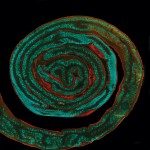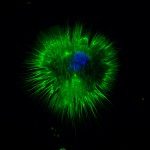Link to Pubmed [PMID] – 31535973
Link to HAL – mnhn-02381076
Link to DOI – 10.7554/eLife.47460
eLife, 2019, 8, pp.e47460. ⟨10.7554/eLife.47460⟩
In most vertebrates, the upper digestive tract is composed of muscularized jaws linked to the esophagus that permits food ingestion and swallowing. Masticatory and esophagus striated muscles (ESM) share a common cardiopharyngeal mesoderm (CPM) origin, however ESM are unusual among striated muscles as they are established in the absence of a primary skeletal muscle scaffold. Using mouse chimeras, we show that the transcription factors Tbx1 and Isl1 are required cell-autonomously for myogenic specification of ESM progenitors. Further, genetic loss-of-function and pharmacological studies point to MET/HGF signaling for antero-posterior migration of esophagus muscle progenitors, where Hgf ligand is expressed in adjacent smooth muscle cells. These observations highlight the functional relevance of a smooth and striated muscle progenitor dialogue for ESM patterning. Our findings establish a Tbx1-Isl1-Met genetic hierarchy that uniquely regulates esophagus myogenesis and identify distinct genetic signatures that can be used as framework to interpret pathologies arising within CPM derivatives.




